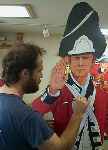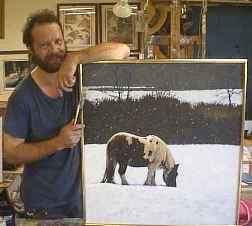Becoming Michigan

"Smelling Smoke" 1997 - van Frankenhuyzen
Ojibwe Indian legend tells the story of the dunes. It is the story of a mother bear and her cubs who, chased by a forest fire in Wisconsin, flee into and across Lake Michigan to the northwestern shore of Michigan's lower penninsula.
Born in the Netherlands in 1951, van Frankenhuyzen was five years old when he decided that he would someday be a painter. "My Dad was a big believer in making your hobby your profession," he tells me during a visit to his studio behind his home. But, it was not a good time to be a painter in Holland, as the country was still recovering from World War II and art was a luxury many could not afford.
"My Dad had his biggest worries about me," van Frankenhuyzen says. "'There is no way you can make a living painting,' he told me." When he was old enough for university, his father advised him to learn a profession, so he studied graphic design at the Royal Academy of Art. Graphic design did not satisfy the young artist and he took evening classes in painting for three years while he earned his degree.
 Sunday, September 6, 1998, Bath, Michigan -
Gijsbert van Frankenhuyzen lives with his wife Robbyn and daughters Heather and Kelly on a beautiful, twenty-seven acre farm in southern Michigan, 186 miles from the Sleeping Bear Sand Dunes.
Sunday, September 6, 1998, Bath, Michigan -
Gijsbert van Frankenhuyzen lives with his wife Robbyn and daughters Heather and Kelly on a beautiful, twenty-seven acre farm in southern Michigan, 186 miles from the Sleeping Bear Sand Dunes.

"Late Afternoon, Masai Mara" 1994 - van Frankenhuyzen
Out of school, he quickly got a job at an advertising agency in the Netherlands and he quickly hated it. "I worked there for a year," he says. "And I don't think I did anything I was proud of."
In the mid-seventies, van Frankenhuyzen took a vacation to the United States, where he saw a copy of the Michigan Natural Resources Magazine.
One look and he knew that this was where he would live and this was where he would work - and he would paint!
But getting a job at that magazine and getting to America would be about as easy as swimming across the ocean. For the next eleven months he made postcards of his work and sent them to the editor of the magazine. Finally, he got the response he wanted. He could have the job, if they could only get through the paperwork.
This was no small task. The state had to try to hire someone from Michigan to satisfy the state's guidelines and it had to try to hire an American to satisfy the federal immigration guidelines. The state ran several advertisements for the position while van Frankenhuyzen waited.
In 1976, after six long months of filling out paperwork, anxiously waiting on every phone call and letter and resubmitting forms and more paperwork, van Frankenhuyzen landed the job. The magazine was unable to find anybody with as diverse a background as his. "My Dad was right," he says proudly. "I got my job because of my graphic skills."

"Morning Light" 1997 - van Frankenhuyzen
He was excited about starting a new life in America and thrilled to be able to do what he loved; to be able to paint for a living. But he had tired of one thing.
So weary was van Frankenhuyzen of paperwork, that he almost turned down a free airline ticket to the states. After World War II, the Dutch government was actually trying to encourage emigration from its over-populated country, according to van Frankenhuyzen, and would pay passage for anybody wishing to leave - all they needed to do was fill out the proper forms.
During a phone call to the government office in charge of this policy, he declined the offer. "I told them; 'I am not going to fill out any more paperwork,'" he says. The clerk was bewildered and told him to come to the office the next morning and they would complete the forms right there. He left that office with a plane ticket, $25 spending cash and the world as his oyster.
van Frankenhuyzen was leaving a life in the Netherlands which he could not bear, a life without the type of work for which he had great passion, a life of crowded, dangerous cities where he felt unsafe. "I've never had the urge to go back," he says, even though he was leaving his family behind and traveling across the great Atlantic Ocean to a land that was still strange to him.

From the book; "Legend of Sleeping Bear" 1997 - van Frankenhuyzen
The Ojibwe legend continues as the Mother Bear arrives on the shore of Michigan and realizes that her cubs had become lost during the long swim across the great lake.
van Frankenhuyzen worked as Art Director for the Michigan Natural Resources Magazine for seventeen years, painting wildlife to illustrate articles and directing the layout of its pages. During this time he met his wife, Robbyn, and they have had two daughters; Kelly and Heather.
Since he left the magazine in 1993, he has become a United States citizen and has expanded his artistic boundaries to include teaching both children and adults. "One woman is in her eighties - she loves to paint flowers. I have a four year old that is incredible," he says.
His demeanor makes it hard to stereotype him as a typical, moody, introspective, quiet artist. His personality is more suited toward teaching; he is vibrant and excited and he easily conveys his passion for art. He regularly talks through a smile.
"I got kind of burned out on wildlife, because I did it for seventeen years," he says. But two projects have kept him portraying the work of Mother Nature. For each of the past ten years, van Frankenhuyzen's art has been chosen for inclusion in the Leigh Yawkey Woodson, Birds in Art Exhibition in Wausau, Wisconsin.
van Frankenhuyzen's most exciting venture developed over the past two years. A book publisher, Sleeping Bear Press, asked him to illustrate a children's book that Kathy-jo Wargin was writing about the sleeping bear dunes area. The book would be titled The Legend of Sleeping Bear and it took van Frankenhuyzen a year to paint twenty-one panels and a dustcover.
Each panel takes up a two-page spread in this coffee table book and they are beautiful. Using each page fully, with no margins, he gracefully captures the eloquence of nature and the beautiful mystery of folklore.
This June, if I had begun this trip in Michigan, instead of New York, I may have written about how this artist was just another artist with just another children's book and how you should buy a copy because boy, they've just printed plenty of them.
That it is so popular, that it tells an actual legend of the state of Michigan and that it tells it so well, are some of the reasons why this book has been nominated as Michigan's Official State Children's Book, an honor van Frankenhuyzen is proud to have.
That's what I like about the book and the figures," he says. "There's more to them than just display - there's a purpose." This book serves an extra purpose indeed, as twenty-five cents from the sale of each book goes into a state fund to purchase books for schools - that's well over $10,000 so far.
Mother Bear lay on the shore through the winter, waiting for her cubs, then for years and years after, she lay there, hoping they would appear. The book tells the most beautiful part of this legend:
"The spirit brought the cubs near shore, raising them out of the water as two magnificent islands, placing them forever within the watchful and caring eyes of Mother Bear.
"The cubs now stand suspended in time as the North and South Manitou Islands."
What about the family van Frankenhuyzen left behind in the Netherlands? "My dad has been over here ten times - distance means nothing today." he says. His father enjoys sleeping in the small cabin van Frankenhuyzen built on the farm's pond. His brother lives and works in nearby Saulte Saint Marie and van Frankenhuyzen enjoys daily life with his wife and children.
The legend of mother bear being reunited with her family has become a treasured part of the state of Michigan. Gijsbert van Frankenhuyzen is becoming as much a part of Michigan as legends are made of.
 van Frankenhuyzen loves to paint murals and life-sized figures. He has painted murals for public schools and businesses. As we talk, he paints several figures; British Grenadiers for Fort Michilimackinac, his second technical work for the state parks. His first is displayed at Fort Mackinac on Mackinac Island.
van Frankenhuyzen loves to paint murals and life-sized figures. He has painted murals for public schools and businesses. As we talk, he paints several figures; British Grenadiers for Fort Michilimackinac, his second technical work for the state parks. His first is displayed at Fort Mackinac on Mackinac Island.
 But June is long gone and so are the books. The first printing of twenty thousand copies sold out in mid-June. The publisher printed twenty-five thousand more and those are gone as well. Already in its third printing, Legend of Sleeping Bear is one of the most popular children's books in Michigan.
But June is long gone and so are the books. The first printing of twenty thousand copies sold out in mid-June. The publisher printed twenty-five thousand more and those are gone as well. Already in its third printing, Legend of Sleeping Bear is one of the most popular children's books in Michigan.

Gijsbert "Nick" van Frankenhuyzen beside one of his newer works;
"Winter Morning" 1998
Learn more about The Legend of Sleeping Bear.
Visit the Artist's web site: Gijsbert van Frankenhuyzen
